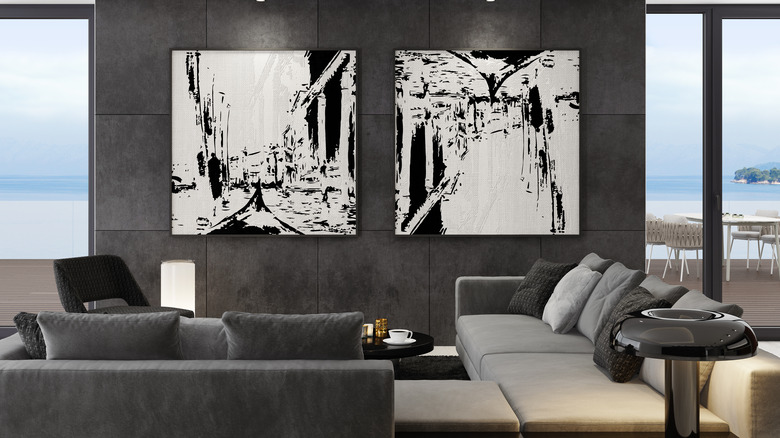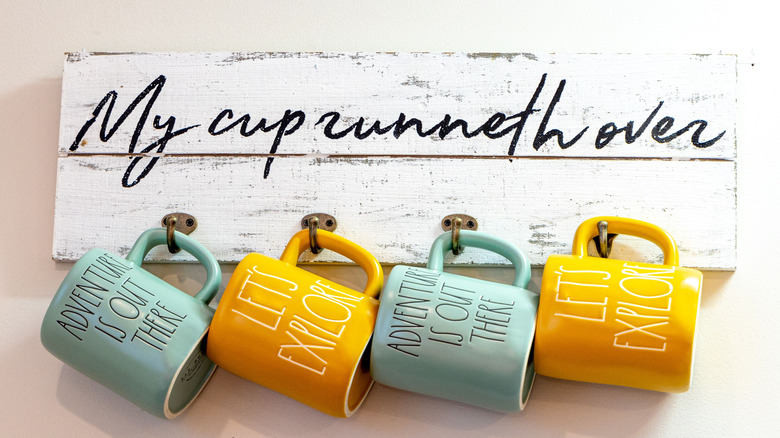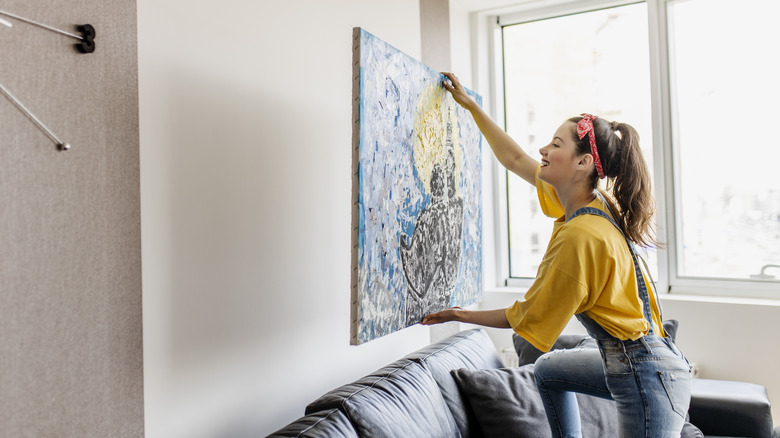Outdated Wall Art Trends You Should Really Avoid, According To Our Home Design Expert
Keeping up with wall art trends might feel like a lot of extra effort when you're more focused on furniture or an overall design aesthetic. But, what you hang on your wall can become a statement piece, helping to elevate the vibe of your space. Whitney Vredenburgh, owner of home staging and design company Nested Spaces, spoke exclusively with House Digest and explained that wall art can help establish a clear personality and "finish" each room. "Imagine a blank wall begging for artwork, the space, no matter how lovely the furniture and accessories will not feel complete," she said.
Even so, don't be tempted to overcompensate with too much wall art. Gone are the days when papering the walls with tacky decals and photographs were all the rage. Instead, designers advise you to ditch the wall clutter in favor of a less-is-more approach. This is especially true if you live in a one-bedroom or a small city apartment. When you have limited space, one of the worst things you can do is draw attention to it with huge, hanging macramés or generic, oversized pieces of IKEA wall art.
To stay in keeping with the more popular design aesthetics today, minimalism is a must. You can still put your personal stamp on any space, but it's best to avoid outdated trends. As Vredenburgh explained, this can be anything from farmhouse-era decor to inappropriately sized paintings, both of which she still sees often in people's homes.
Skip the farmhouse-era stuff
Whitney Vredenburgh told House Digest in an exclusive interview that outdated wall trends include farmhouse-inspired decor — which is fine if you live in a farmhouse. But, even if you embrace all things cottage core, try to resist. "The majority of the population does not live in a farmhouse," Vredenburgh shared. "So, start discarding your milk jug pictures with a stem in it with a rustic wooden frame or your steer artwork you found at T.J. Maxx. Also consider donating your artwork with quotes and phrases like 'live, laugh, love.'" In particular, "live, laugh, love" signs have become a joke among younger generations who view them as inauthentic decor, which only proves Vredenburgh's point. A country-style house doesn't need farmhouse decorations like rustic wheels or clocks for purely superficial reasons.
Instead, Vredenburgh encourages homeowners to think about imbuing their walls with sentimental pieces or prints with meaning, such as local artists' work. "Maybe you have a favorite vacation spot you'd love to get commissioned or a favorite landmark like a national park that makes you smile when you think about it," she encouraged. In this way, your walls can tell a story that organically complements and meshes with the rest of your design aesthetic. For example, one of Vredenburgh's clients missed the beach after moving to landlocked Indianapolis. "Instead of plastering photos of beaches on the walls, we opted to use blues throughout the home and sourced an abstract painting of the sea," the designer said.
Inappropriately sized wall art is a no-go
Another outdated wall decor trend is when paintings aren't the right size. If a print doesn't fit a given space, it will throw the whole room off. "Most people tend to buy artwork that is too small for a space," Whitney Vredenburgh exclusively shared with House Digest. How to tell if the painting doesn't work? "Measure where the artwork will go," Vredenburgh explained. "[If] it's above a console table or sofa, it should be 5-8 inches shorter than the table on each side, and about 6-8 inches above the table or sofa. If it's floating on a wall, the midpoint should be 60 inches from the floor."
It may also be helpful to think about wall art ideas for each individual room in your house. For example, canvases come in standard sizes, with differently sized pieces better suited for specific places. Mini canvases (think 5-inch-by-7-inch or 6-inch-by-8-inch prints) are tiny space fillers that work well on shelves or hanging in a vertical line wherever the wall may jut out. One step up from that are small canvases (8 inches by 10 inches), which will look great in entryways and hallways. Medium canvases (16 inches by 20 inches) are commonly found in kids' bedrooms or family rooms, while large statement canvases are ideally found in adult bedrooms and living rooms. Something like a triptych canvas is unusual and eye-catching enough to transform a master suite, but you should always measure your space first to determine that it will fit.


